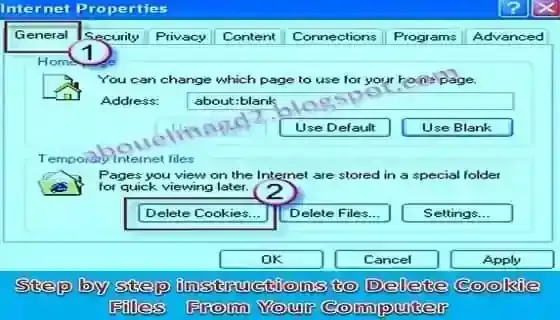Do you realize how to erase treated documents from your PC? If not, here are some basic guidelines. As a matter of first importance let us start by clarifying what a treat is. Treats are little bits of content created by a web server and put away in the PC of a web client when the person visits a site that offers treats.
 |
| Step-by-step instructions for deleting cookies from your PC |
The treat is an interesting identifier that the webserver puts on the PC hard drive and this enables associations to store data on the client’s machine and to later recover it. There are different real and helpful uses for treats however because of the potential for misuse, significantly, you realize how to erase threats from your PC.
An assortment of data can be put away in a treat record. A few associations use treats to follow everything you might do on their site, others store client distinguishing proof and passwords to spare rehash guests rounding out structure data each time they visit.
Anyway, different associations may utilize treats to profile client propensities and perusing propensities and that data would then be able to be passed on to others for promoting purposes.
What Are Cookies?
A treat is a little snippet of data about you and your computerized inclinations sent from a site and put away on your PC. The sort of data site recoveries can go from your own subtleties like name, address, and telephone number to harmless material like what you were seeing, or your shopping basket (in case you’re buying something). By putting away treats on your PC, a site doesn’t need to demand that data each time you visit it, which saves time and permits a site to customize your visit. Treats are very advantageous and generally innocuous. In addition, since they’re plain content records, they can’t be executed or contaminate your PC.
The explanation that you’ve started to see pop-ups requesting that you permit treats is a direct result of a new EU law, which requires EU organizations to tell web clients of their following treats and permit them to pick in or out.
Cookies, Cache, and Browsing History
Treats are not the same as your store or program history. A web reserve is another snippet of data that is put away on your PC. Dissimilar to treats that store your data, reserve incidentally stores web archives, for example, HTML pages. This permits sites you’ve effectively visited stack rapidly and utilize less transfer speed. Then again, your perusing history is basically a record of the relative multitude of sites you’ve visited. It doesn’t store anything explicit about the locales other than their location.
The most effective method to Delete Cookie records:
Web Explorer:
Web Explorer 6 for Windows 98, Windows 98 Second Edition, Windows Millennium Edition, Windows NT 4.0, Windows 2000, and Windows XP
Start Internet Explorer.
On the Tools menu, click Internet Options, and afterward, click the General tab.
In the Temporary Internet Files segment, click Delete Cookies, click OK, and afterward click OK once more.
NOTE: If utilizing a more established variant of Internet Explorer then you should physically erase the treats from your hard drive as pursues:
Start Internet Explorer.
On the Tools menu, click Internet Options, and afterward, click the General tab.
In the Temporary Internet Files segment, click Settings.
Snap View Files.
On the View menu, click Details.
Snap the Internet Address section header, and afterward discover the Internet locations of the treatment records.
For instance, a treat Internet address might be named like the accompanying name: Cookie:username@websitename.com
Snap a treat record, and afterward press DELETE.
If you are incited to affirm that you need to erase the record, click Yes. Rehash this progression for every treat record.
Firefox:
Snap the Tools menu pursued by Options.
Feature the security button.
Snap the unmistakable catch beside the treats button.
Snap the reasonable catch alongside the reserve button.
